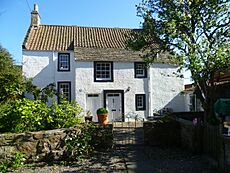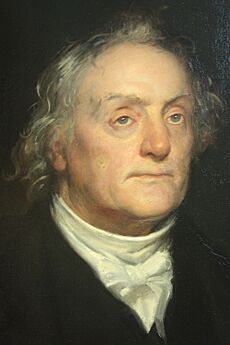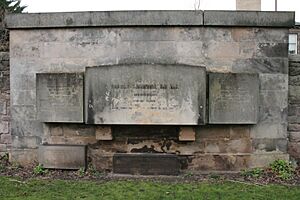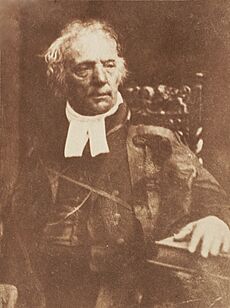Thomas Chalmers facts for kids
Quick facts for kids
Thomas Chalmers
FRSE
|
|
|---|---|

Thomas Chalmers by John Faed, 1847
|
|
| Born | 17 March 1780 Anstruther, Fife, Scotland
|
| Died | 31 May 1847 Edinburgh, Scotland
|
| Education | University of St Andrews University of Edinburgh |
| Occupation | Theologian, Presbyterian minister |
| Theological work | |
| Tradition or movement | Presbyterianism |

Thomas Chalmers (17 March 1780 – 31 May 1847) was an important Scottish Presbyterian minister. He was also a professor, an expert in how countries manage their money (called a political economist), and a major leader in two big churches in Scotland: the Church of Scotland and the Free Church of Scotland. Many people called him "Scotland's greatest church leader" of the 1800s.
Chalmers was a Vice-president of the Royal Society of Edinburgh from 1835 to 1842. The town of Port Chalmers in New Zealand is named after him. You can also see a statue of him in the Hall of Heroes at the National Wallace Monument in Stirling. The Thomas Chalmers Centre in Kirkliston is also named in his honor.
Contents
Early Life and Studies
Thomas Chalmers was born in Anstruther, a town in Fife, Scotland. His mother was Elizabeth Hall, and his father was John Chalmers, a merchant.
When he was just 11 years old, Chalmers started studying mathematics at the University of St Andrews. In 1799, he became a licensed preacher. After more studies at the University of Edinburgh and helping a math professor at St Andrews, he became the minister of Kilmany church in 1803. Kilmany was a small farming area with fewer than 800 people.
Teaching and Ministry Work
Chalmers was very passionate about teaching mathematics. He even taught his own classes when the university stopped his lectures. At the same time, he also taught chemistry and served his church in Kilmany.
In 1815, Chalmers became the minister of the Tron Church in Glasgow. Some people in the town council didn't want him because of his strong religious teachings. But he became very famous as a preacher across the United Kingdom. When he visited London, a famous leader named Samuel Wilberforce said, "everyone is excited about Dr Chalmers."
Helping His Community
In 1817, Chalmers spoke about the need for Christians to help improve the social conditions in Glasgow. His church parish had about 11,000 people, and many of them didn't go to any church. He believed that the church organizations in the city hadn't grown with the population.
He suggested building 20 new churches in Glasgow. The city council agreed to build one new church for 10,000 people, mostly factory workers and laborers. Chalmers became the minister of this new church, called St John's, in 1819.
He started by setting up schools for children. Two school buildings were built, and 700 children learned there for a small fee. He also opened 40 to 50 local Sabbath schools where over 1,000 children were taught. Chalmers divided the parish into 25 smaller areas, each with 60 to 100 families. He was at the center of this system, visiting families and holding evening meetings to help the community.
Professor of Philosophy and Theology
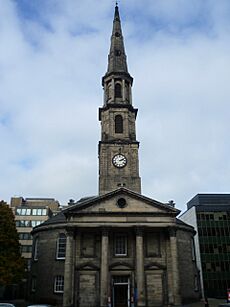
In 1823, Chalmers became a professor of moral philosophy at the University of St Andrews. This was the seventh job offer he received during his eight years in Glasgow! His lectures inspired some students to become missionaries.
In 1828, Chalmers moved to the University of Edinburgh to become a professor of theology (the study of religion). He started a new way of teaching, where he would ask students questions after his lectures. He also introduced textbooks.
In 1834, Chalmers was chosen as a member of the Royal Society of Edinburgh. He also became a member of the Institute of France. Oxford University gave him an honorary degree (DCL) in 1835. At this time, he lived in a house at 3 Forres Street in Edinburgh.
He became a leader of the evangelical group within the Scottish Church. He led a committee to build more churches. By 1841, he announced that over £300,000 had been raised, and 220 new churches were built in just seven years! He tried to get the government to help, but they didn't.
Church Leadership and the Free Church
Chalmers became the leader of a group in the Church of Scotland that believed in "non-intrusionism." This meant that a minister should not be forced into a church parish if the people there didn't want him.
There were disagreements between the church and the government about this. The courts said the church had to follow their rules. The church asked the government for help, but in 1843, the government said no to the church's request for independence.
This led to a major event called the Disruption. On May 18, 1843, 470 ministers left the Church of Scotland. They formed a new church called the Free Church of Scotland, and Chalmers became its first leader. He also created a special fund to support the ministers who left.
In 1844, Chalmers started another campaign to build new churches for the Free Church. In 1846, he became the first head of the new Divinity Hall of the Free Church of Scotland, which was a school for training ministers. He once said that the most important thing was the "Christian good of the people of Scotland," not just the church itself.
Later Life and Death
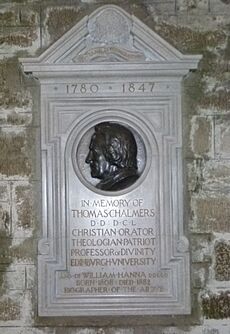
On May 28, 1847, Chalmers returned home to Morningside, near Edinburgh, after a trip to London. The next day, he was working on a report for the Free Church. On Sunday, May 30, he seemed well and went to bed planning to finish his report early the next morning. But on Monday, May 31, he was found dead in his bed.
Thomas Chalmers was buried in Grange Cemetery on June 4, 1847. He was the very first person buried there. His grave is on the north wall of the cemetery. A large crowd of people from all different churches came to his funeral. His wife, Grace Pratt, and two of his daughters are also buried with him.
His Writings and Ideas
Chalmers wrote many books and articles, filling over 30 volumes! People at the time thought he was a great writer about God and nature. In 1817, he published sermons about how discoveries in astronomy related to Christian beliefs. These sermons were very popular, with 20,000 copies sold in a year.
Ideas on Money and Society
In 1808, Chalmers wrote about how countries get and keep their money. He was one of the first to discuss how fertile land affects a community and how wealth grows. He also argued that religious organizations should be supported by the community, not just left to market forces like other businesses.
He wrote about how the good moral behavior of people helps them be financially stable. He believed that good character leads to comfort, not the other way around.
Helping the Poor
Chalmers had a lot of experience helping the poor in his parish. He became an important thinker on the topic of poverty. He believed that poverty was partly caused by families having too many children. He also thought that people who helped the poor should be well-trained and that help should come from voluntary donations, not forced taxes.
When Chalmers took over St John's parish, helping the poor cost the city £1400 each year. In just four years, he reduced this cost to £280 per year! He had volunteers investigate new requests for help and tried to teach people to help themselves. He was against forced taxes for the poor, believing that voluntary help was better.
Moral Lessons
In his lectures, Chalmers taught about people's duties to God and to each other, based on Christian teachings. He wrote about how people make choices, pay attention, and how our moral feelings are separate from other feelings.
Religious Views
Chalmers wrote an article about Christianity for an encyclopedia. This, along with other writings, made him well-known as an author. He believed that the Church of Scotland was important because it helped people become better Christians.
Science and Faith
Chalmers wrote a famous book in 1833 about how God's power and wisdom are seen in nature. These books were like an encyclopedia of natural history before Charles Darwin's ideas about evolution became widely known.
He also believed that the story of creation in the Bible could fit with the idea of a very old Earth. He suggested that there was a long period of time between the first two verses of the Book of Genesis. This idea is called "gap creationism."
This idea means that the six days of creation in the Bible were literal 24-hour days, but there was a huge gap of time between the first and second verses of Genesis. This helped explain scientific observations, like the age of the Earth. This is different from believing that the "days" of creation were millions of years long, or that the Earth is only a few thousand years old.
Family Life
Thomas Chalmers and his wife, Grace, had six daughters. His oldest daughter, Anne, married William Hanna, who later wrote a long book about Chalmers' life. His second daughter, Elizabeth, worked as a supervisor of nurses during the Crimean War.
Chalmers' brother, Charles Chalmers, started the Merchiston Castle School. Charles' son, David, who was Thomas' nephew, became a well-known industrialist.


